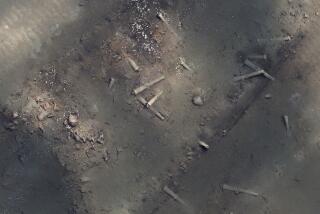Cannons of Henry Morgan believed found
- Share via
Archaeologists have recovered six cannons from the ships of Welsh privateer Henry Morgan, the first artifacts found in Panama to be linked to the man who remains a legend there, the team said Monday.
In the late 1600s, Morgan sent three ships and a crew of 470 men to capture the Castillo de San Lorenzo el Real de Chagres, a fort that guarded the approach to Panama City, the capital. Morgan and his men were sailing up the Chagres River to join them when his flagship, the Satisfaction, and at least three other vessels crashed on Lajas Reef, sinking in shallow water.
Members of Morgan’s force paddled upriver and traveled overland to reach Panama City, which they successfully sacked. But their wrecked ships were abandoned and left to amateur archaeologists and looters.
“Every school kid learns about Morgan’s activities, but we have never seen any of his materials,” said archaeologist Tomas Mendizibal, a research associate at Patronato Panama Viejo, a government agency that is overseeing excavation of the original site of Panama City. “If these are indeed his cannons, it would be a first.” Mendizibal was not involved in the discovery.
Morgan is generally thought of as a pirate, but he was commissioned as a privateer by the English crown to attack enemy vessels and protect the British colonies of Barbados and Jamaica because the Royal Navy was unable to do so. He became the scourge of the Spanish in the Caribbean and was eventually knighted and made governor of Jamaica.
An American-Panamanian team has been exploring the mouth of the Chagres River since 2008, documenting its rich history. Christopher Columbus came across it in 1502 on his fourth voyage to the New World and it became the gateway to Panama City, Spain’s main port in the Pacific.
After the decline of the Spanish Empire in the late 18th century, the city became a backwater port and an entree for smuggling and illicit trade. With the California Gold Rush, the Chagres River again saw a flurry of activity, but the construction of the Panama railroad shifted transit traffic to the port of Colon and by 1855 the river was again a backwater.
At the edge of the Lajas Reef, the team found what appeared to be a field of six cannons, all covered with layers of sedimentary rock that had built up over the centuries, said archaeologist James P. Delgado, director of the National Oceanic and Atmospheric Administration’s Maritime Heritage Program in Silver Spring, Md., and a co-leader of the team. The cannons seem to be from the 17th century and five are probably French.
Morgan’s flagship “was a captured French vessel, and the mix [of cannons] is the type of thing one would expect for a privateer,” Delgado said. “These guys grabbed whatever they could get a hold of.”
At least two more guns are buried in the sand, along with an anchor, ceramics, bottles and other artifacts, he said. Magnetometers indicate that other metal objects are buried more deeply.
“The only wrecks that we know of that happened on that reef are his,” said Delgado, who worked with colleagues from Texas State University-San Marcos, the Waitt Institute in La Jolla and Panama’s National Institute of Culture. Moreover, an old map found in local archives indicates the site of the wreck is the location where the team found the cannons.
The archaeologists had not intended to bring the cannons to the surface, but treasure hunters have apparently been working at the site. “There is evidence of explosions, heavy gouging and digging and massive scooped-out areas,” Delgado said. “The reef has really been hit hard,” forcing their hand.
More to Read
Sign up for Essential California
The most important California stories and recommendations in your inbox every morning.
You may occasionally receive promotional content from the Los Angeles Times.













